2,996cc SOHC Inline 6-Cylinder Engine
Bosch Mechanical Fuel Injection
240bhp at 6,100rpm
4-Speed Manual Transmission
4-Wheel Independent Suspension
4-Wheel Hydraulic Drum Brakes
*The Makris Gullwing - Single family ownership from new
*Matching-numbers example, retaining its original factory Rudge wheels, engine and bodywork
*Eligible for the most exclusive driving and Concours d'Elegance events around the globe
*Superb, factory-correct restoration performed by Mercedes specialists
THE MERCEDES-BENZ 300SL GULLWING
Instantly recognizable not only by automobile buffs, but virtually anyone on the planet, the immortal 300SL (for Sports Leicht) Gullwing coupe arguably competes for the title of "Greatest Sports Car of the 1950s," and surely qualifies for anyone's Top 10 list of the greatest automobiles of all time. A period favorite of wealthy celebrities, it ranks today among the most valued and collectable sports cars ever produced.
The 300SL Coupe was the direct descendant of Mercedes-Benz' Le Mans W194 competition coupe, conceived in 1952 and aimed at wresting the World Sportscar Championship from Alfa Romeo, Ferrari, and Lancia, which were dominating post-war endurance racing. Mercedes Benz historian W. Robert Nitzke writes that company management wanted to jump back into Grand Prix racing, where it had been so successful before the war, but lacked the time necessary to design, build, and develop a new single-seater for the 1954 season. Instead, Chief Engineer Fritz Nallinger suggested that the company build a new two-seat sports car utilizing the strong in-line SOHC six-cylinder engine from its luxurious 300 series. Because the engine and drivetrain were relatively heavy, the chassis would have to be extremely light. Test Department manager Rudolf Uhlenhaut, having some experience with tubular chassis design, sat down with construction engineer Joseph Müller and laid out an extremely light (154 pounds) and rigid lattice-work chassis capable of accommodating the big in-line six. One major problem soon presented itself: there was no way to mount conventional doors without compromising the rigidity of the chassis. The solution was to raise the entry so that the doors cut into the roof, but that meant hinging them from the top, thus giving birth to this car's timeless signature design feature.
The 300SL's first racing trial was the 1952 Mille Miglia, where Kling finished second to Giovanni Bracco's open Ferrari, while Rudolf Caracciola was fourth, the two Gullwings being split by a Lancia. The third Coupe had gone off the road early in the grueling contest. Next came the Grand Prix of Berne, where a quartet of 300SLs took the start and swept the top three positions, Caracciola having crashed in what would prove to be his last race.
Then came Le Mans, where Uhlenhaut struck fear into the competition by bringing an SL coupe fitted with a hand-operated air brake mounted on the roof. While that particular car was not raced, Mercedes would tuck the idea in its pocket for future use. After the grueling 24-hour epic, a pair of 300SLs had finished in the top two positions...and were then driven back to the factory!
Mercedes-Benz sat out the 1953 and 1954 sports car seasons, concentrating instead on developing its new Grand Prix car. But, the SLs weren't done. they reappeared in 1955 as the airbrake-equipped 300SLR, utilizing that feature and numerous more of the advancements were successfully tested on the company's Formula One racing cars. The year would bring triumph and tragedy: 300SLRs winning at Buenos Aires, the incredibly difficult Mille Miglia—where Stirling Moss and Denis Jenkinson won at a record average speed of just under a hundred miles an hour—the Nurburgring, Spa, Zandvoort, Aintree, Kristianstad, Monza, Dundrod, and Sicily's Targa Florio. The only setback, and one that would have devastating consequences, occurred at Le Mans, where team driver Pierre Levegh and more than 80 spectators died in one of racing's worst accidents, prompting Mercedes-Benz to withdraw from racing for many years.
New York imported auto entrepreneur Max Hoffman, credited with urging Mercedes Benz to build a production sports car based on the 300SL racing car. The 300SL Gullwing, in final form, was unveiled at the New York International Motor Sports Show in early February 1954, and actual production began that fall. The new coupe was slightly changed in appearance from the racing coupes and featured Bosch direct fuel injection. This prompted the factory to claim it was, "the fastest German production sports car." Between 1954 and 1957, a total of 1,400 Gullwings were delivered to eager purchasers, and in 1957, the elegant and improved 300SL Roadster appeared. These proved to be even more successful from a sales standpoint, with 1,858 units produced.
THE MOTORCAR OFFERED
Hand-built at the Mercedes-Benz works in during the Summer of 1956, this exceptional Gullwing boast unparalleled pedigree, having been delivered new to the late father of the consignor. According to Eric le Moine's impressive Gullwing Registry, the new Gullwing was completed at the factory on the 6th of September 1956. Destined for the US market, the new car was soon after shipped to Max Hoffman's Mercedes-Benz agency in New York, NY. The Gullwing was fitted with the sportier, Rudge alloy wheels from the factory, and painted DB180 Silver Metallic, while trimmed in neatly contrasting Dark Blue leather, code 333. Once stateside, pioneering car collector and charismatic, International Greek shipping magnate George C. Makris of Brookville, NY acquired the Gullwing, and the car would remain with him and the Makris Family until today.
The Makris Family summarizes their late fathers spectacular Gullwing:
"Purchased by our father Makris off the assembly line in 1956, both he and our mother used this car daily for many years. George would commute to his Broad Street office in Manhattan. I vividly recall him parking at the curb and tossing the keys to the white gloved door man as he helped six-year-old me out of the upwinged door saying," keep an eye on it James. If it needs to be moved handle her with kid gloves.
This vehicle and I are closely entwined, as our mother would run errands in it, including a charming vignette in 1957 as she got wedged in the bucket seat seven months pregnant with me and quite a comedy with two men trying to lift her out.
Throughout my childhood I often rode in the back boot with George careening the car at 90 mph on 45 mph country roads, loving how the Benz hugged the tight corners. I thought it was a ritual that the police pulled us over to say hello, while in actuality George was receiving another speeding warning.
By the time I was 17 and learned to drive a standard shift on the family Thunderbird, dad and I would take the Gullwing down to the Jones Beach Parkway, he encouraging me to bring her to top speed on the long flat straightaway, as I opened up the pretty chrome throttles. George was a stock car racer at Daytona and Martinsville in the early 50s. In fact, Dan Gurney grew up in his neighborhood, always hanging around the garage while George was beefing up engines on Fords and Mercurys. At one point George had a companion Roadster to our Gullwing. But with his love of restoring and showing cars of the 30s and 40s, sports cars came and went every couple of years from our household- Dino Ferrari, Fastback, Testarossa. But this Gullwing was a keeper.
With his gorgeous wife Patricia dwindling to cancer all too young, George embarked on a flawless restoration of the Gullwing to offset his grief. He wanted to show off both the car and Patricia one last time. It was a poignant day as their Gullwing won with 100 points at Meadowbrook Concours d'Elegance. Dad was able to drive Patricia with him one final time into the winner's circle capturing the thrill of glory. He retired the car from show at that point in her memory".
Used very little in the past few decades, just stored in a climate-controlled environment, the Makris Gullwing was brought back to life in 2022, when German Motor Car Service in Santa Monica, CA changed fluids, drained fuel tank and went through the fuel system. The car required very little work to be back up and running, a testimony to the high build quality of these cars, and of course Mr. Makris' diligent ownership taking such good care of the German sports car. The Gullwing was shown at the 2022 La Jolla Concours, where it received the Phillip Wichard Excellence in Design award.
Today, the 1990s restoration still presents exceptionally well, with just a light patina to the DB534G red exterior paint and lovely tan leather interior. Just 21,858 miles are recorded on the odometer at the time of cataloging, a figure indeed reflecting the original miles according to the Makris family. The factory-fitted Rudge wheels remain on the car, fitted with appropriate Michelin XWX tires. The original underbody belly-pans are still on the car - a feature most 300SLs have lost by now - and original Securit glass stampings remain in place. Chrome and brightwork, as well as lights and lenses, appear to be largely original and preserved. Inside, the original ivory-colored steering wheel is in place, as is the original VDO gauges and switchgear, and a original Becker Mexico radio adorns the dashboard. A 1992 Senior National First Prize at Antique Automobile Club of America (AACA) badge is affixed out front, and neatly fitted in the trunk is the factory jack. The engine compartment has been restored to correct factory finishes, and, keeping with its authenticity, the engine is the matching numbers unit. Fitted luggage is also offered with the car, along with owner's manuals.
This exceptional 300SL Gullwing stands out as a single-family owned car from new and is among the finest examples Bonhams have ever had the pleasure to offer.
2,996cc SOHC Inline 6-Cylinder Engine
Bosch Mechanical Fuel Injection
240bhp at 6,100rpm
4-Speed Manual Transmission
4-Wheel Independent Suspension
4-Wheel Hydraulic Drum Brakes
*The Makris Gullwing - Single family ownership from new
*Matching-numbers example, retaining its original factory Rudge wheels, engine and bodywork
*Eligible for the most exclusive driving and Concours d'Elegance events around the globe
*Superb, factory-correct restoration performed by Mercedes specialists
THE MERCEDES-BENZ 300SL GULLWING
Instantly recognizable not only by automobile buffs, but virtually anyone on the planet, the immortal 300SL (for Sports Leicht) Gullwing coupe arguably competes for the title of "Greatest Sports Car of the 1950s," and surely qualifies for anyone's Top 10 list of the greatest automobiles of all time. A period favorite of wealthy celebrities, it ranks today among the most valued and collectable sports cars ever produced.
The 300SL Coupe was the direct descendant of Mercedes-Benz' Le Mans W194 competition coupe, conceived in 1952 and aimed at wresting the World Sportscar Championship from Alfa Romeo, Ferrari, and Lancia, which were dominating post-war endurance racing. Mercedes Benz historian W. Robert Nitzke writes that company management wanted to jump back into Grand Prix racing, where it had been so successful before the war, but lacked the time necessary to design, build, and develop a new single-seater for the 1954 season. Instead, Chief Engineer Fritz Nallinger suggested that the company build a new two-seat sports car utilizing the strong in-line SOHC six-cylinder engine from its luxurious 300 series. Because the engine and drivetrain were relatively heavy, the chassis would have to be extremely light. Test Department manager Rudolf Uhlenhaut, having some experience with tubular chassis design, sat down with construction engineer Joseph Müller and laid out an extremely light (154 pounds) and rigid lattice-work chassis capable of accommodating the big in-line six. One major problem soon presented itself: there was no way to mount conventional doors without compromising the rigidity of the chassis. The solution was to raise the entry so that the doors cut into the roof, but that meant hinging them from the top, thus giving birth to this car's timeless signature design feature.
The 300SL's first racing trial was the 1952 Mille Miglia, where Kling finished second to Giovanni Bracco's open Ferrari, while Rudolf Caracciola was fourth, the two Gullwings being split by a Lancia. The third Coupe had gone off the road early in the grueling contest. Next came the Grand Prix of Berne, where a quartet of 300SLs took the start and swept the top three positions, Caracciola having crashed in what would prove to be his last race.
Then came Le Mans, where Uhlenhaut struck fear into the competition by bringing an SL coupe fitted with a hand-operated air brake mounted on the roof. While that particular car was not raced, Mercedes would tuck the idea in its pocket for future use. After the grueling 24-hour epic, a pair of 300SLs had finished in the top two positions...and were then driven back to the factory!
Mercedes-Benz sat out the 1953 and 1954 sports car seasons, concentrating instead on developing its new Grand Prix car. But, the SLs weren't done. they reappeared in 1955 as the airbrake-equipped 300SLR, utilizing that feature and numerous more of the advancements were successfully tested on the company's Formula One racing cars. The year would bring triumph and tragedy: 300SLRs winning at Buenos Aires, the incredibly difficult Mille Miglia—where Stirling Moss and Denis Jenkinson won at a record average speed of just under a hundred miles an hour—the Nurburgring, Spa, Zandvoort, Aintree, Kristianstad, Monza, Dundrod, and Sicily's Targa Florio. The only setback, and one that would have devastating consequences, occurred at Le Mans, where team driver Pierre Levegh and more than 80 spectators died in one of racing's worst accidents, prompting Mercedes-Benz to withdraw from racing for many years.
New York imported auto entrepreneur Max Hoffman, credited with urging Mercedes Benz to build a production sports car based on the 300SL racing car. The 300SL Gullwing, in final form, was unveiled at the New York International Motor Sports Show in early February 1954, and actual production began that fall. The new coupe was slightly changed in appearance from the racing coupes and featured Bosch direct fuel injection. This prompted the factory to claim it was, "the fastest German production sports car." Between 1954 and 1957, a total of 1,400 Gullwings were delivered to eager purchasers, and in 1957, the elegant and improved 300SL Roadster appeared. These proved to be even more successful from a sales standpoint, with 1,858 units produced.
THE MOTORCAR OFFERED
Hand-built at the Mercedes-Benz works in during the Summer of 1956, this exceptional Gullwing boast unparalleled pedigree, having been delivered new to the late father of the consignor. According to Eric le Moine's impressive Gullwing Registry, the new Gullwing was completed at the factory on the 6th of September 1956. Destined for the US market, the new car was soon after shipped to Max Hoffman's Mercedes-Benz agency in New York, NY. The Gullwing was fitted with the sportier, Rudge alloy wheels from the factory, and painted DB180 Silver Metallic, while trimmed in neatly contrasting Dark Blue leather, code 333. Once stateside, pioneering car collector and charismatic, International Greek shipping magnate George C. Makris of Brookville, NY acquired the Gullwing, and the car would remain with him and the Makris Family until today.
The Makris Family summarizes their late fathers spectacular Gullwing:
"Purchased by our father Makris off the assembly line in 1956, both he and our mother used this car daily for many years. George would commute to his Broad Street office in Manhattan. I vividly recall him parking at the curb and tossing the keys to the white gloved door man as he helped six-year-old me out of the upwinged door saying," keep an eye on it James. If it needs to be moved handle her with kid gloves.
This vehicle and I are closely entwined, as our mother would run errands in it, including a charming vignette in 1957 as she got wedged in the bucket seat seven months pregnant with me and quite a comedy with two men trying to lift her out.
Throughout my childhood I often rode in the back boot with George careening the car at 90 mph on 45 mph country roads, loving how the Benz hugged the tight corners. I thought it was a ritual that the police pulled us over to say hello, while in actuality George was receiving another speeding warning.
By the time I was 17 and learned to drive a standard shift on the family Thunderbird, dad and I would take the Gullwing down to the Jones Beach Parkway, he encouraging me to bring her to top speed on the long flat straightaway, as I opened up the pretty chrome throttles. George was a stock car racer at Daytona and Martinsville in the early 50s. In fact, Dan Gurney grew up in his neighborhood, always hanging around the garage while George was beefing up engines on Fords and Mercurys. At one point George had a companion Roadster to our Gullwing. But with his love of restoring and showing cars of the 30s and 40s, sports cars came and went every couple of years from our household- Dino Ferrari, Fastback, Testarossa. But this Gullwing was a keeper.
With his gorgeous wife Patricia dwindling to cancer all too young, George embarked on a flawless restoration of the Gullwing to offset his grief. He wanted to show off both the car and Patricia one last time. It was a poignant day as their Gullwing won with 100 points at Meadowbrook Concours d'Elegance. Dad was able to drive Patricia with him one final time into the winner's circle capturing the thrill of glory. He retired the car from show at that point in her memory".
Used very little in the past few decades, just stored in a climate-controlled environment, the Makris Gullwing was brought back to life in 2022, when German Motor Car Service in Santa Monica, CA changed fluids, drained fuel tank and went through the fuel system. The car required very little work to be back up and running, a testimony to the high build quality of these cars, and of course Mr. Makris' diligent ownership taking such good care of the German sports car. The Gullwing was shown at the 2022 La Jolla Concours, where it received the Phillip Wichard Excellence in Design award.
Today, the 1990s restoration still presents exceptionally well, with just a light patina to the DB534G red exterior paint and lovely tan leather interior. Just 21,858 miles are recorded on the odometer at the time of cataloging, a figure indeed reflecting the original miles according to the Makris family. The factory-fitted Rudge wheels remain on the car, fitted with appropriate Michelin XWX tires. The original underbody belly-pans are still on the car - a feature most 300SLs have lost by now - and original Securit glass stampings remain in place. Chrome and brightwork, as well as lights and lenses, appear to be largely original and preserved. Inside, the original ivory-colored steering wheel is in place, as is the original VDO gauges and switchgear, and a original Becker Mexico radio adorns the dashboard. A 1992 Senior National First Prize at Antique Automobile Club of America (AACA) badge is affixed out front, and neatly fitted in the trunk is the factory jack. The engine compartment has been restored to correct factory finishes, and, keeping with its authenticity, the engine is the matching numbers unit. Fitted luggage is also offered with the car, along with owner's manuals.
This exceptional 300SL Gullwing stands out as a single-family owned car from new and is among the finest examples Bonhams have ever had the pleasure to offer.
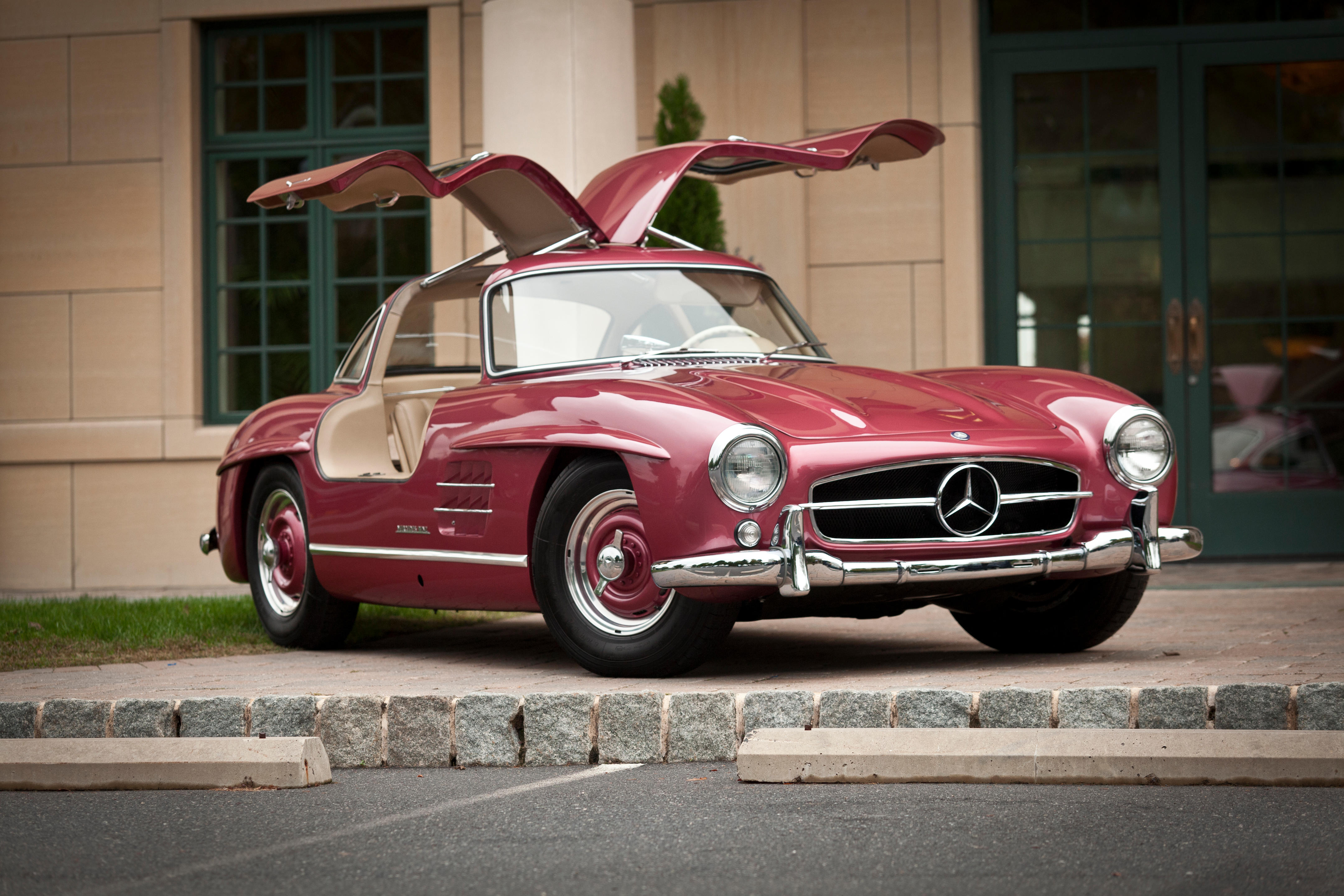
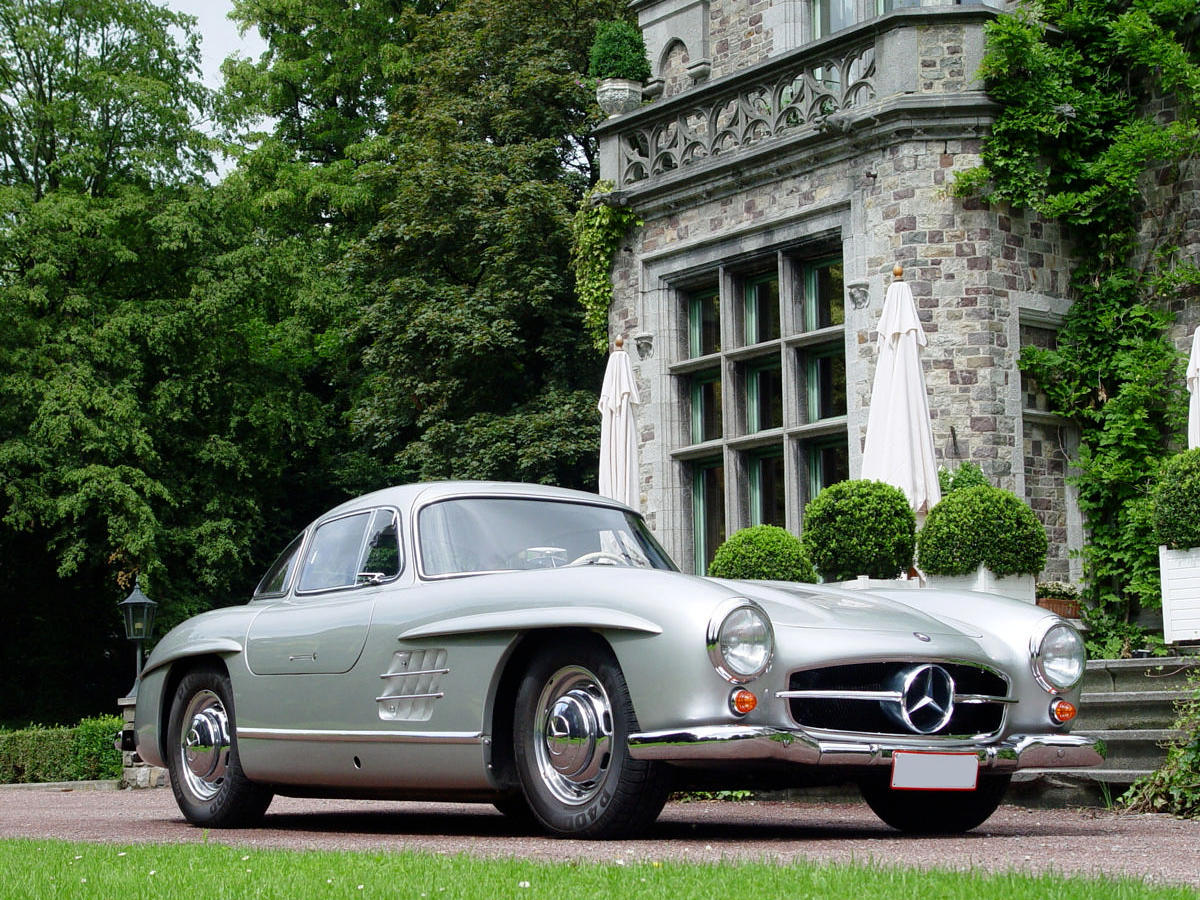
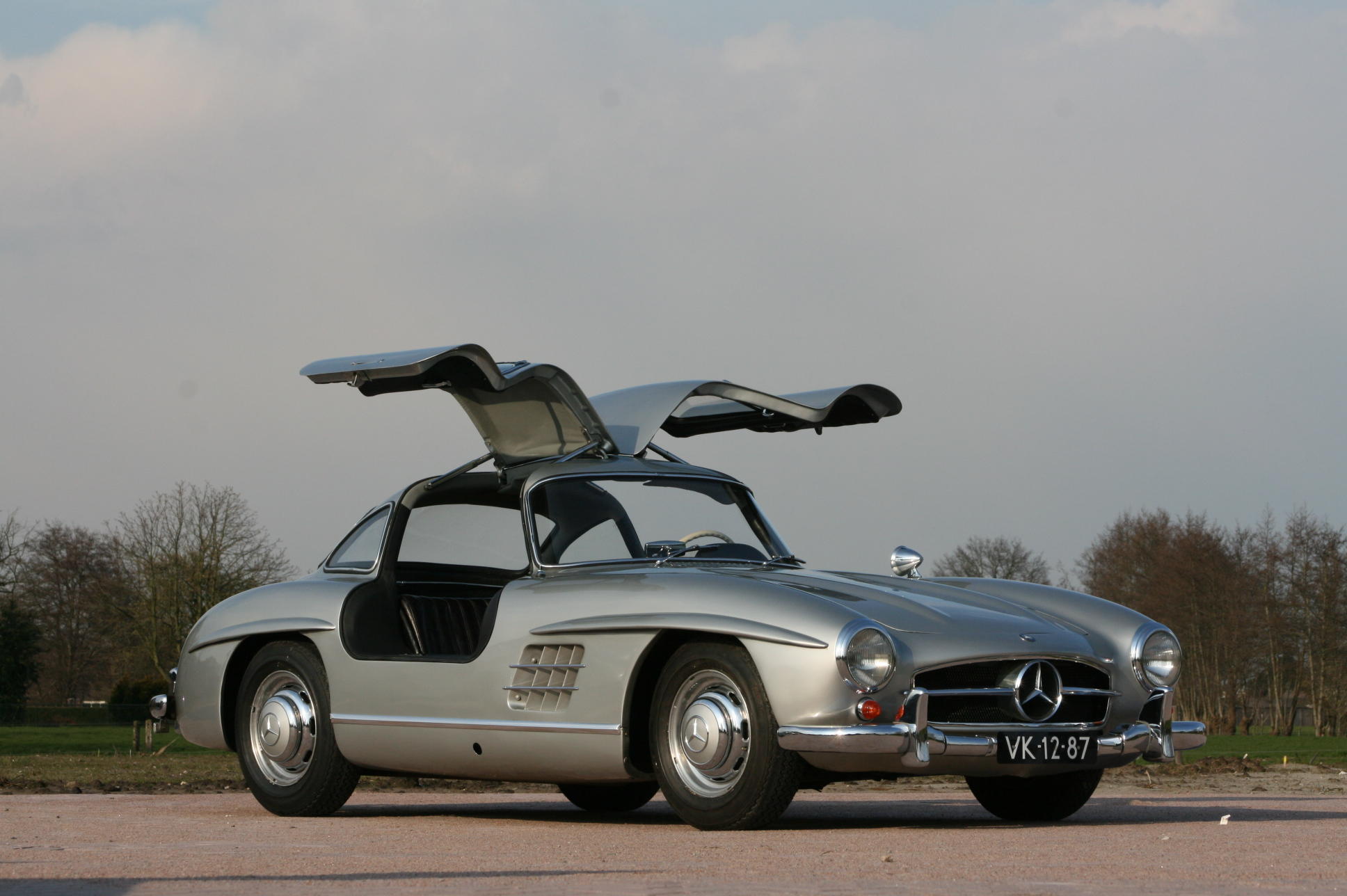
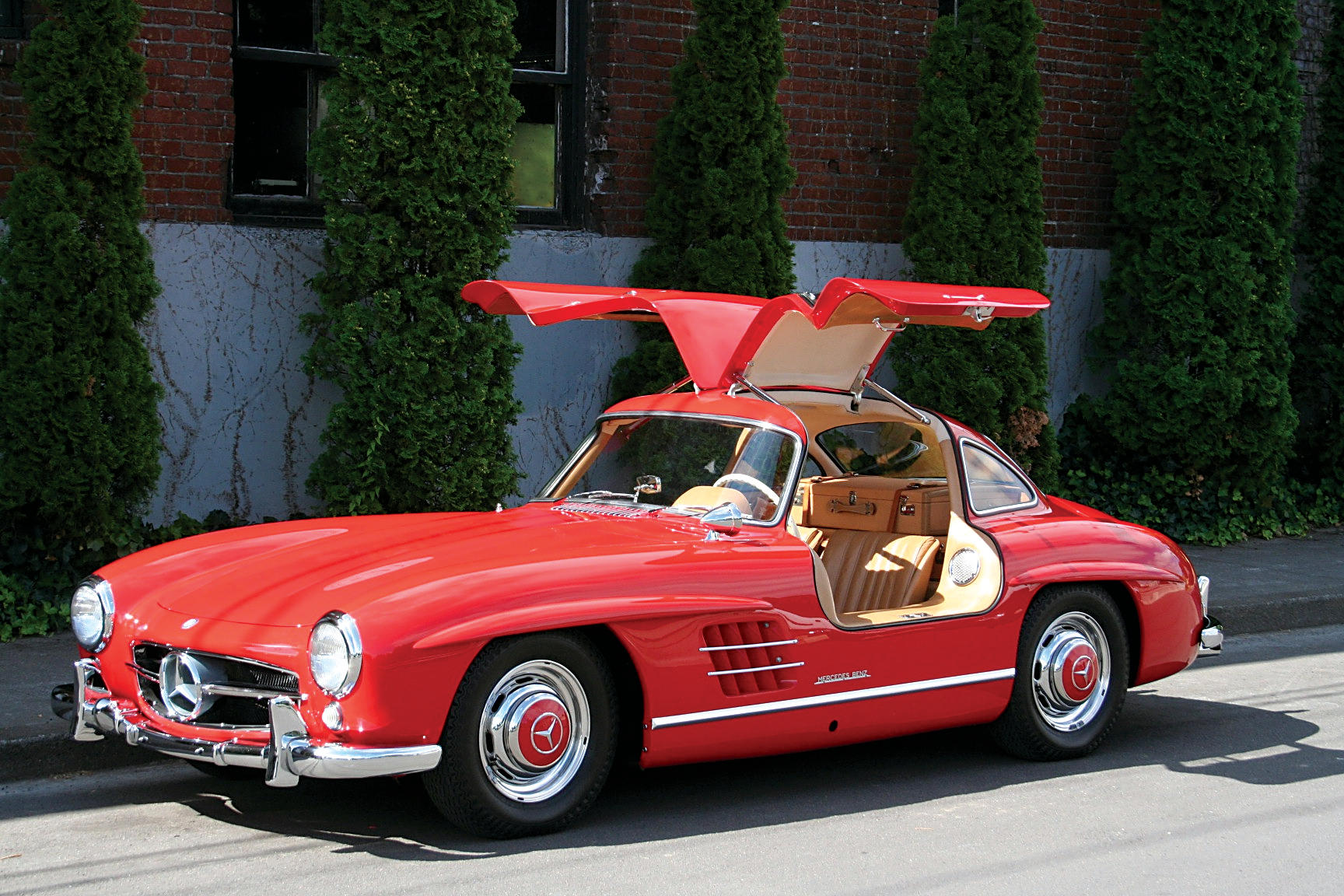
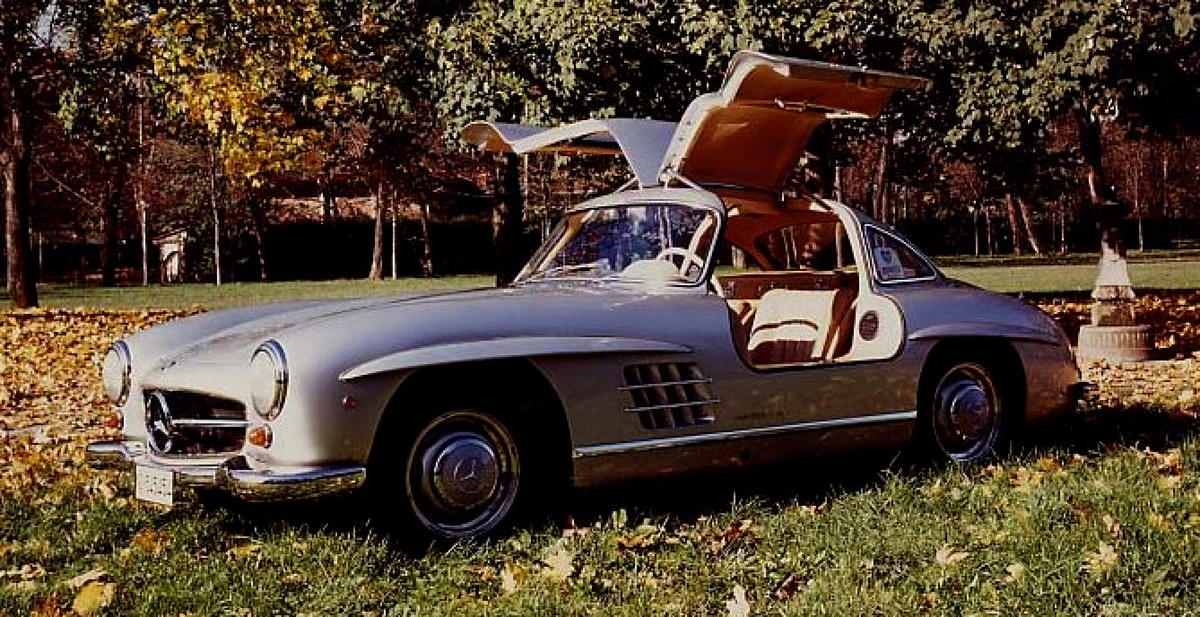
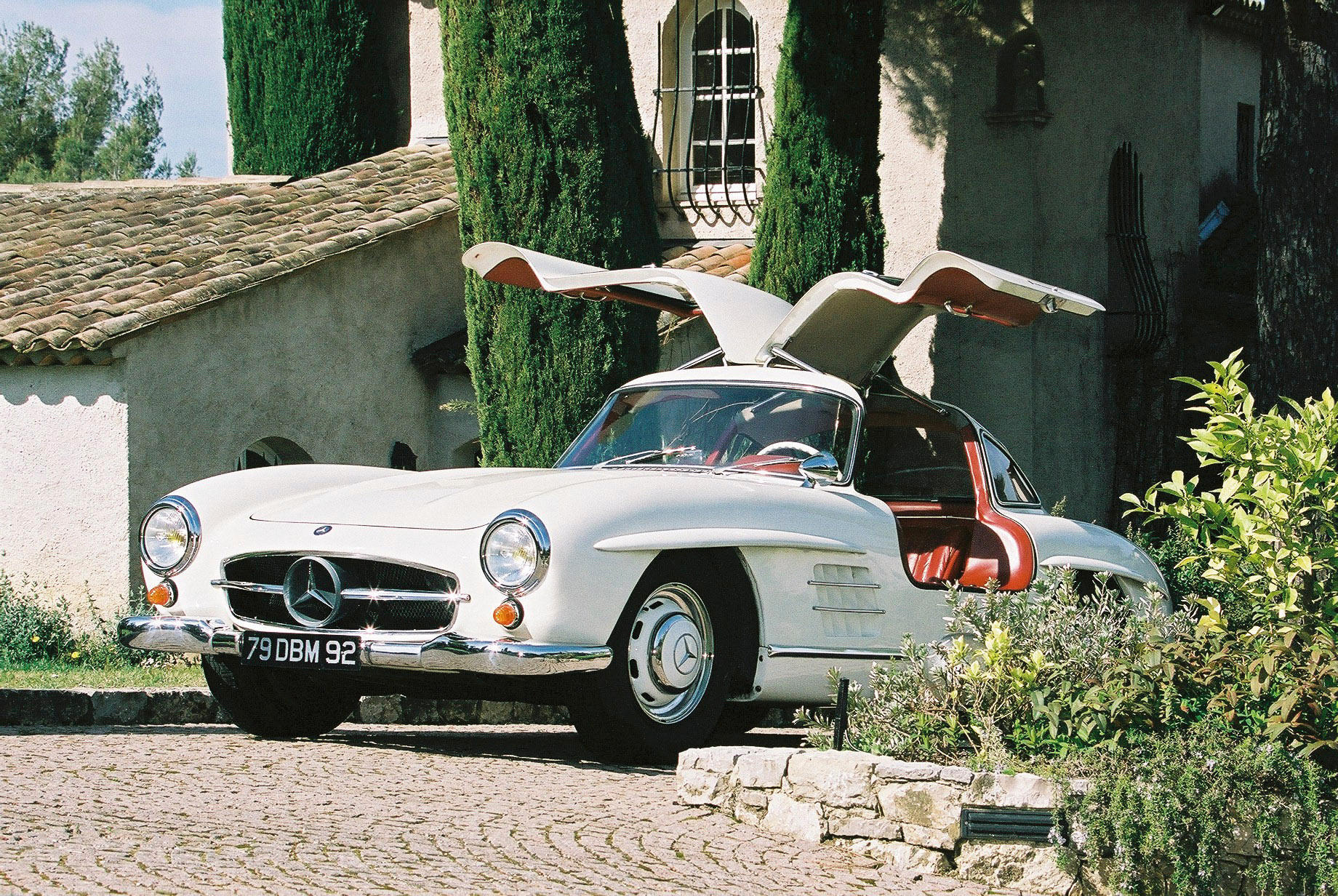




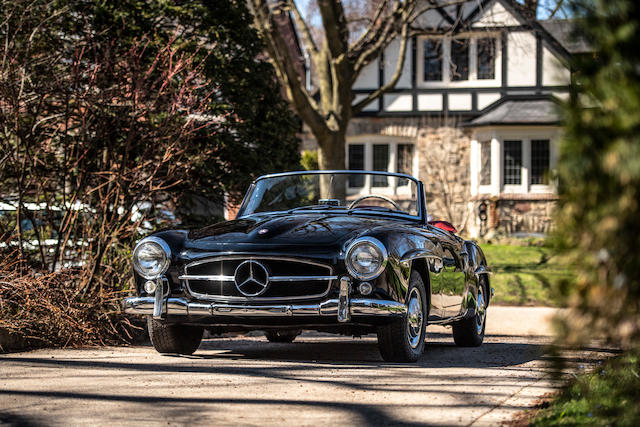




Testen Sie LotSearch und seine Premium-Features 7 Tage - ohne Kosten!
Lassen Sie sich automatisch über neue Objekte in kommenden Auktionen benachrichtigen.
Suchauftrag anlegen